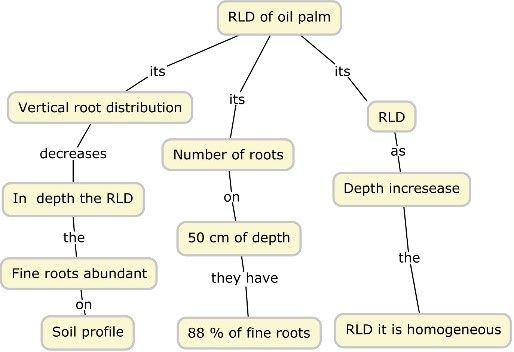Root length density (RLD) of oil palm (Elaeis guineensis Jacq) in a haplic Luvisol in Chiapas, Mexico
DOI:
https://doi.org/10.48162/rev.39.049Keywords:
fine roots, number of roots, soil profile, absorption of nutrientsAbstract
The tight relationship between root architecture and uptake capacity of soil water and minerals, is well established. Support roots, generally long-lived, perform support functions such as transportation and food storage. Absorbing roots, thin and short-lived, absorb nutrients and regulate plant metabolism. Roots distribution in the soil profile is crucial for plant development. It optimizes resource usage and ensures a prompt response to seasonal changes. This work aimed to study the vertical distribution of the root system of nine-year-old oil palms in a haplic Luvisol, low fertility, moderately acidic, with Nitrogen (N) and Potassium (K) deficiency, average content of Phosphorous (P), and medium to low Cation Exchange Capacity (CEC). Using the cylinder method, soil samples were collected every 10 cm and down to 150 cm of soil depth, from each cardinal side of three soil profiles. The results showed that oil palms had good root development. Most roots (73%) were found in the first 30 cm of soil, with a predominance of fine roots (78%). At 50 cm in depth, fine roots represented 88%, thin roots, 67% and medium roots, 94%. Further study should assess root length density at 15, 20, 25, and 30 years.
Highlights
- Haplic luvisols are optimal soils for oil palm cultivation due to their depth (> 150cm), over 50% base saturation, and pH of 5.5-6.6.
- Root length density (RLD) decreased as soil depth increased. Although most oil palm roots are found in surface horizons, roots can still be found at depths of up to 1.5-5 m.
- The highest number of oil palm roots (73%) was found in the first 30 cm, with 78% of fine roots.
- Fine roots were distributed throughout the entire soil profile, evidencing high nutrient-absorption and metabolic activities.

Downloads
Published
Issue
Section
License
Copyright (c) 2018 Revista de la Facultad de Ciencias Agrarias UNCuyo

This work is licensed under a Creative Commons Attribution-NonCommercial-ShareAlike 3.0 Unported License.
Aquellos autores/as que tengan publicaciones con esta revista, aceptan las Políticas Editoriales.


